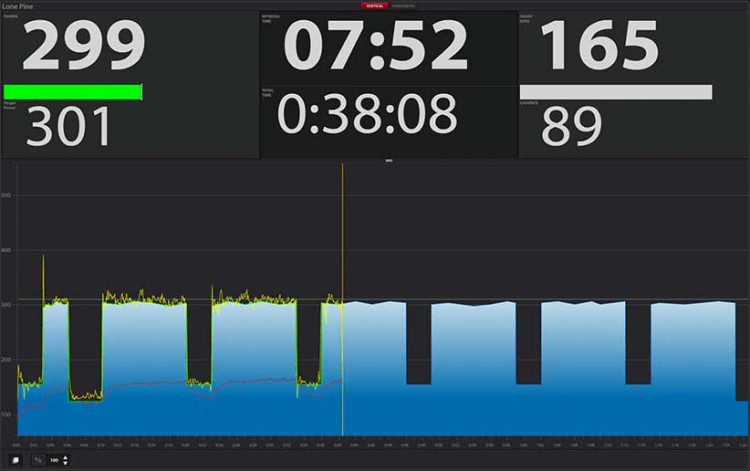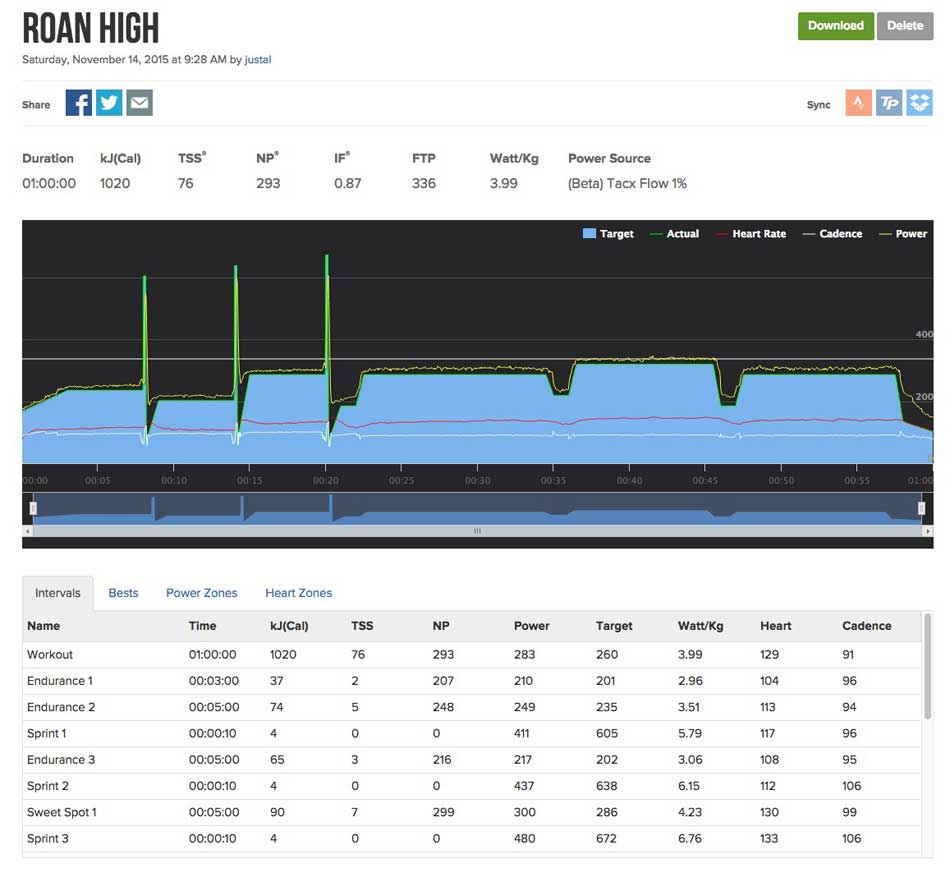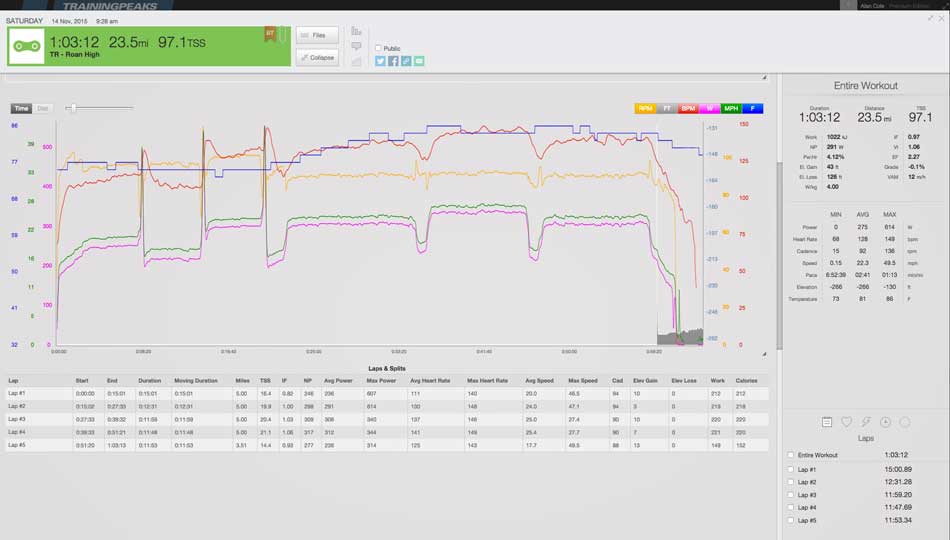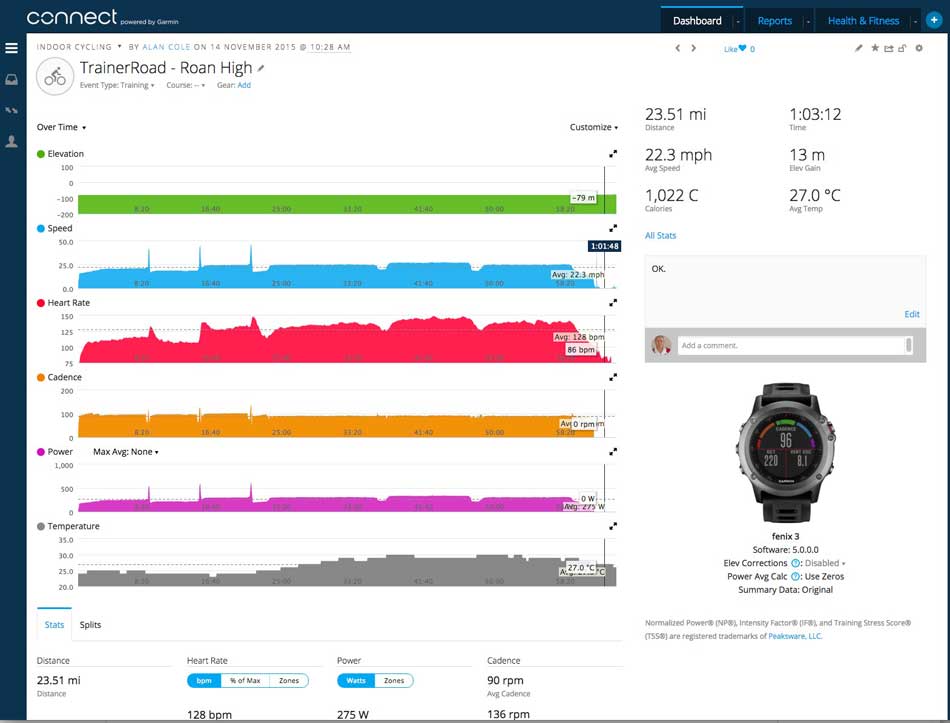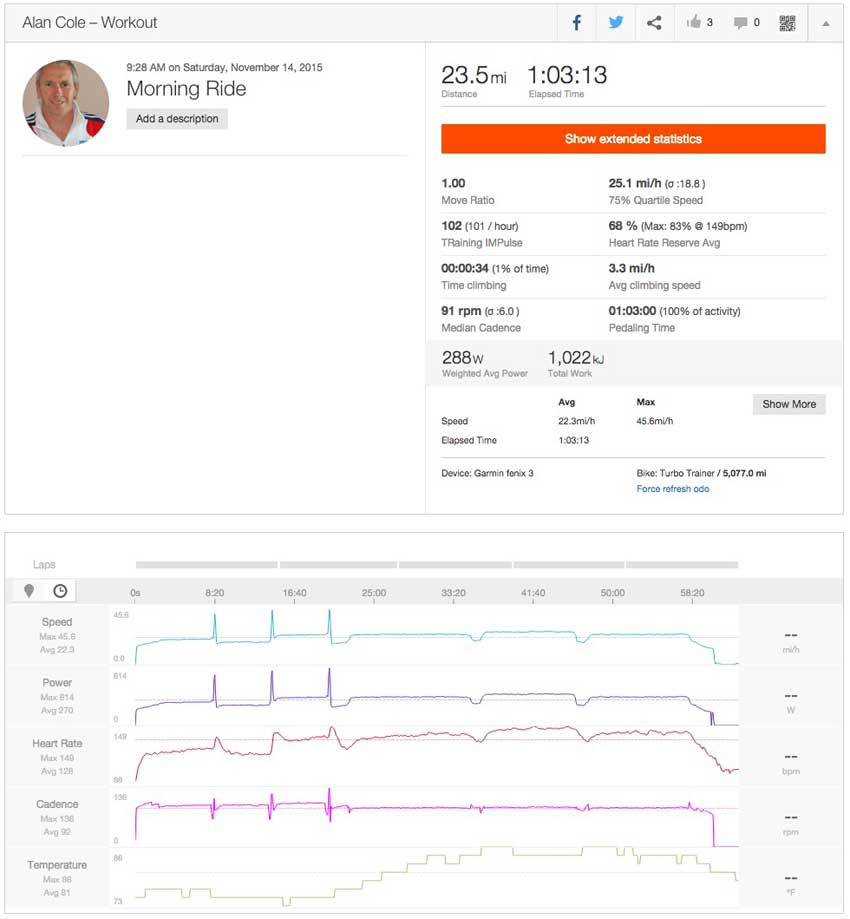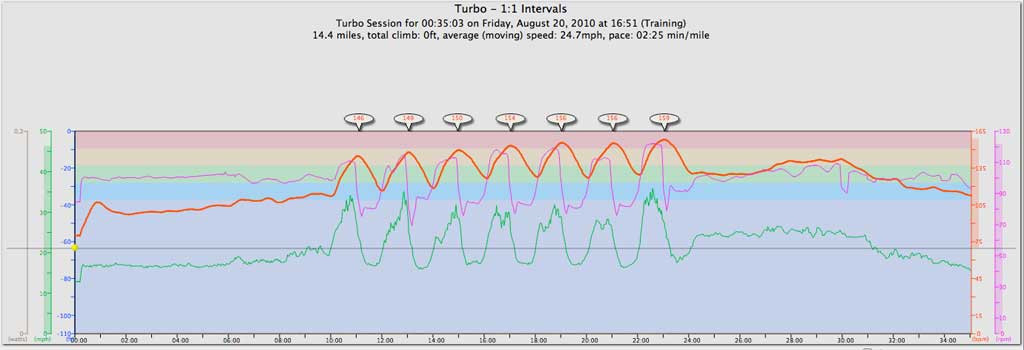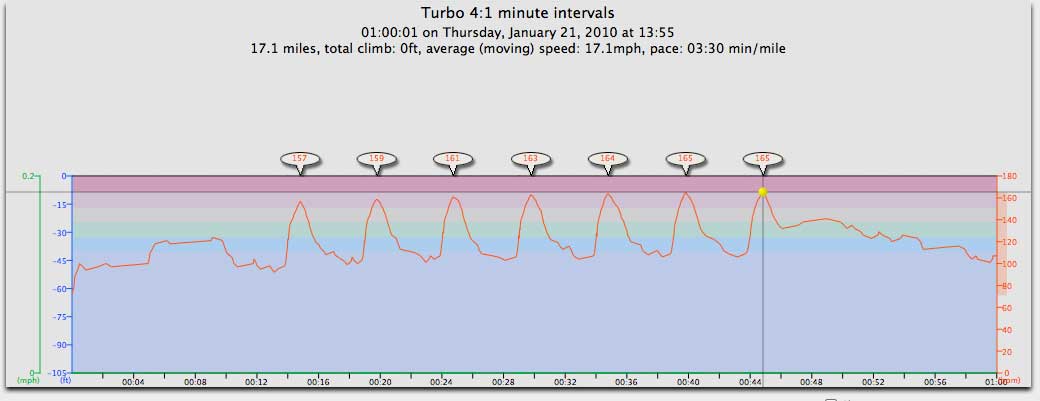Ultimate Turbo Trainer Set Up, Gadgets, Software and Workflow
I’m quite pleased with my turbo trainer set up, the software I use with it, the ‘workflow’ I have to record everything and the gadgets that I use to make this happen. I’ve mentioned many of them here in passing, but thought I’d write a post about the whole kit and caboodle. What I use, how it all works together and the results I get from it. I’ll no doubt mention a few upgrades that I could get down the line as well.
Turbo Trainer Set Up
Before we get started on the specifics, it’s important to recognise that training on the bike indoors isn’t the most inspiring of activities. It works wonders and is almost a necessity over the long Welsh winter but it’s not everyones cup of tea. So, making it easy to do, providing incentives to do it and making sure there are as few things to get in the way of a trainer session as possible are all important. I actually quite enjoy and almost look forward to turbo trainer sessions over the winter and I think this comes down to the fact that I have a perfect turbo trainer set up which is easy to use, always ready to go and provides me with plenty of variety and motivation to actually do the sessions.
If you can get a similar turbo trainer set up in place then maybe you too will actually enjoy endless hours on the turbo trainer.
The Turbo Trainer
First up, the turbo trainer itself. This is of course all important and probably the next thing to be updated in my quest for the ultimate turbo trainer set up. At the moment I’m using what is now quite an old Tacx Flow turbo trainer. It’s a fairly robust ergometer trainer with electro-magnetically controlled resistance that can be set from the handlebar mounted computerised head unit. You can use it in either ‘slope mode’ of ‘ergo mode’.
- Slope Mode means that the trainer is set at a certain resistance or ‘slope’ so the higher your cadence or larger gear that you use, the more power you generate.
- Ergo Mode means that the resistance is automatically adjusted by the trainer so that your power output remains the same whatever your gearing and cadence.
Both modes are useful. If you have the turbo trainer set up on its own and are using it to hit specific intervals at specific wattages then ergo mode is for you. Warm up at a certain wattage, then just as the interval starts push a few buttons to ramp up the wattage so that you are forced to maintain that wattage throughout the interval whatever gear or cadence you choose. Then at the end of the interval reduce the wattage so that you can recover before hitting the next interval. This is how I used to train, but now that I use TrainerRoad sessions I tend to use slope mode so that it’s virtual power curves match up to those of the turbo trainer. TrainerRoad receives speed and cadence information from my turbo trainer sessions and is able to calculate virtual power from these based on known power curves for my particular model of turbo trainer. In order to do this, it is necessary to set up the make, model and slope setting of your turbo trainer in the TrainerRoad software, which therefore necessitates the need for using it in slope mode.
Even though my Tacx Flow turbo trainer is now over 6 years old, it’s still going strong and serving me well. A shame in some respects as it would be nice to upgrade to one of the new generation of ‘smart’ turbo trainers such as the Tacx Vortex Smart. These allow two way communication (via either ANT+ or Bluetooth) between software such as TrainerRoad and the turbo trainer. This means that as well as the software receiving data from the turbo trainer, it is also able to send data to it and therefore able to adjust settings on the turbo trainer as well. This allows you to use a smart turbo trainer in conjunction with software such as TrainerRoad in what is essentially an automatic ergo mode. If the software workout says you should be at 300 watts, it will automatically adjust the trainer to 300 Watts in ‘ergo-mode’ and from there the trainer will make sure that’s what you are outputting whatever your cadence and whatever your gearing. As soon as your interval ends and the prescribed wattages drops, the turbo trainer will once again automatically adjust the resistance to ensure you are performing at the prescribed power output.
The Bike
Probably the most important contributing factor allowing me to jump on the turbo trainer for a workout with as little procrastination as possible is the fact that I have a dedicated bike just for the turbo trainer. There’s no pfaffing about putting my road bike on the trainer, changing wheels, changing tyres or anything like that. I have one bike for the road and one bike for the trainer so that my turbo trainer set up is always ready to go. The bike on my turbo trainer set up is a VERY old, (no, make that ‘antique’), steel framed bike that isn’t even close to being roadworthy, but it does the job.
The only downside to having such an old bike constantly fixed to my turbo trainer set up is the fact that the geometry of this bike is very different to that of my road bike. I’ve managed to get it as close as possible though using a whole load of blue sticky circles and an app on my iPhone called Bike Fast Fit. The bike also has tubular wheels which can be a bit of a pfaff, but I’ve found that the very inexpensive Continental Giro tubs seem to last foreever on my turbo trainer set up – something that can’t be said for all tyres.
Bike Gadgets
In order that the software such as TrainerRoad, and my Garmin watch can tell what I’m up to on the bike, I have a Garmin Speed and Cadence Sensor fitted to the bike. As it’s name implies, this detects the speed I’m ‘travelling’ at based on the revolutions of my rear wheel on the turbo trainer, and the cadence I’m pedalling at based on sensors on one of the crank arms. This is then transmitted via ANT+ to my computer and to my watch.
Other than that, there’s very little in the way of gadgets on the bike itself other than the head unit of the Tacx Flow turbo trainer which is fitted to my handlebars and gives me a heads up display of my speed, power, cadence, time etc. Actually, that’s a lie, when my head is ‘up’ I look at the laptop screen in front of me. The Tacx Flow head unit is more useful when my head is down and I’m a sweating, exhausted, dribbling wreck! Yes, this is generally the outcome of a turbo trainer session.
Recording – Watches and Head Units
As mentioned above, the speed and cadence sensor transmits data to my watch. I’m currently using a Garmin Fenix 3 which is an all singing, all dancing multi-sport smart watch. It does so much more than record what I’m up to when turbo training, but it works perfectly for these indoor bike sessions as well. In addition to receiving speed and cadence data, it receives heart rate data from my Garmin ANT+ heart rate monitor strap, and also receives virtual power data from TrainerRoad using a system known as Trainer Relay which relays the virtual power that the software has calculated back to my watch.
You could of course use pretty much any cycle specific head unit for such purposes, or any of the other multisport watches out there as well. I do like my Garmin Fenix 3 though, and I can’t recommend it enough – It’s a lovely watch, if it had a built in optical heart rate sensor then it would be perfect, but no doubt that’s what the Fenix 4 will be all about!
The Fan
Next on the list of essentials is a ‘gert big fan‘. It gets pretty hot and sweaty whilst training indoors, even in the depths of winter in our conservatory which can be freezing this is still a necessity. A towel to mop up the sweat and a drinks bottle is essential too.
The Laptop
As you’ve probably already worked out by now, I use some software called TrainerRoad whilst on the turbo trainer. This runs on Mac, Windows, iOS and Android, but I tend to run it on a fairly old laptop that sits just in front of my turbo trainer set up. It doesn’t need to be a particularly powerful computer so nothing fancy here. It does need a Wi-Fi connection though and a USB port so that I can connect an ANT+ dongle to it which then allows the various ANT+ sensors to communicate with it.
The Software
This is what brings it all together, I have the turbo trainer set up as above all ready to go whenever I need it, then on the laptop I have the TrainerRoad Software, again, it’s usually open and ready to go, all in the name of having as few barriers as possible to getting on my turbo trainer and riding.
TrainerRoad
I’ve mentioned TrainerRoad quite a few times over the years in this weblog. There are quite a few alternatives out there now all of which do similar thing, but I still like TrainerRoad. Essentially, it’s an online collection of turbo trainer workouts and training plans. You choose which plan you want to follow and which workout you want to do on a given day and then the software shows you what you should be doing. As mentioned above if you have a modern ANT+ or Bluetooth LE enabled ‘smart’ turbo trainer then TrainerRoad will communicate with your turbo trainer and adjust the resistance for you so that you conform to the intervals in the workout. If like me you only have a speed and cadence sensor sending data to TrainerRoad then the onus is on you to conform to the workout by watching the on screen prompts and the onscreen changes in power output.
Here’s what the Screen looks like partway through a TrainerRoad session on the turbo trainer.
The blue shows the power outputs that you are aiming for, the yellow vertical line shows you where you are in that workout and the yellow trace behind it shows your actual power output. The red line shows your heart rate. At the top left is your power output at the moment, and below it your target power. The green line between them changes from green, to yellow to red if your power veers away from the target. The other numbers show the time remaining for the current interval, the total time of the workout so far, your heart rate and your cadence.
And that’s all there is to it whilst on the turbo trainer. You can of course watch a video whilst following a TrainerRoad session and TrainerRoad integrates with cycling workouts from the likes of Sufferfest which can add some excitement to the proceedings. I generally stick my iPod on and listen to a podcast. Talking of which, TrainerRoad themselves have quite an interesting podcast that I subscribe to.
Once the session is finished, TrainerRoad automatically uploads the results to your account and adds it to your ‘career’ so that you can look back at it. When my turbo trainer session is over I stop my watch and jump in the shower, which in the interests of least resistance and keeping things easy, is right next to my turbo trainer. While I’m in the shower my Garmin Fenix 3 uploads the data from my turbo trainer session to Garmin Connect. This happens automatically over my Wi-Fi network and from there it is automatically synced to both Training Peaks and Strava and this is what it looks like.
TrainerRoad
Here’s what it looks like once it gets to the ‘my career’ section of TrainerRoad.
This particular session called ‘Roan High’ is a fairly simple base phase workout mainly below my FTP, with just three sprints early on. As you can see, I performed fine, keeping the yellow line (denoting my power output) just above the blue target output throughout, with only subtle changes in heart rate as well. Above the graph are some overall stats for the workout, and below it a breakdown of stats for each interval.
Training Peaks
Once into Training Peaks, that very same workout looks like this:
Very similar of course if a little less easy to understand for those unfamiliar with the Training Peaks software. All the data is there though and you can drill down into more details if you wish. It also has some extra data in the form of speed, elevation and temperature all of which are fairly academic during a turbo trainer session
Garmin Connect
I don’t actually use Garmin Connect as much as I used to as I tend to use Training Peaks for planning and analysing my training these days, but my Fenix 3 auto uploads workouts to Garmin Connect and it is from here that it is synced to other online software such as Training Peaks and Strava, so this is what the same workout looks like in Garmin Connect.
Once again, all the data is there in a nice easy to read and colourful format and you can drill down into more details for each interval if you wish.
Strava
Finally, the auto sync that I have set up within Garmin Connect also sends my workouts to Strava. This is fairly pointless for a turbo trainer workout but is very handy for sessions in the real world. I’m not going to turn it off just for turbo trainer workouts so they end up in my Strava feed along with everything else. It’s not a bad thing as it’s just another place that the data is stored and the workouts look OK in Strava too. Here’s the exact same workout in Strava.
Improvements
As far as I’m concerned I have pretty much the perfect turbo trainer set up. It’s always there ready to go with as few points of resistance as possible. I just fill up my water bottle, don my cycling shorts and jump on. TrainerRoad is fired up on the laptop and away I go. I tend to plan what sessions I’ll be doing in advance as well, so I don’t even have to think about that. I just do the prescribed workout and the whole process doesn’t take much longer than the workout itself.
Once I’ve finished, not only have I done some decent training but I’ve caught up with some podcasts. I then jump in the shower and by the time I’m done all of my data has been synced to the the various online training diaries and my hard work has been recorded.
It would be nice to have one of the new ‘smart’ turbo trainers that would automatically adjust resistance based on the TrainerRoad workout that I’m following. It’s not essential though and it all works the way that I have it set up so there’s no need to buy one of these just yet. Other than that, there’s little that could be improved. Maybe a large screen TV rather than the laptop just so that I could sit there for hours pedalling away whilst watching epic movies, but again, I’m quite happy catching up with podcasts really. All in all it’s pretty much the ultimate turbo trainer set up which most importantly actually encourages me to do these all important indoor workouts.
Sponsors.
If you would like to sponsor me and get some positive exposure for your business at the same time, please get in touch or use the donate button below. I'll do my best to make it worth your while.I'm currently racing for Scimitar Sports Racing Team and Beet-it Sport

